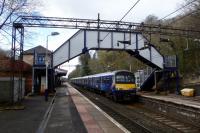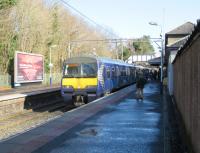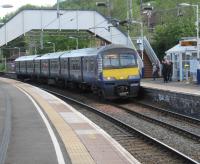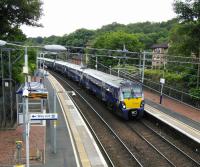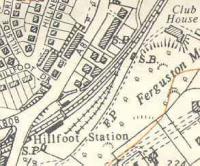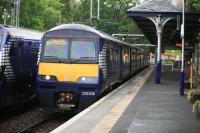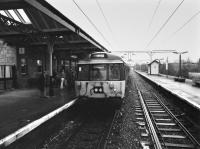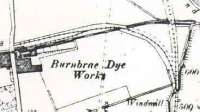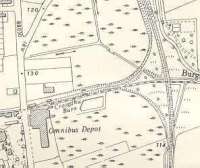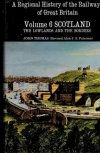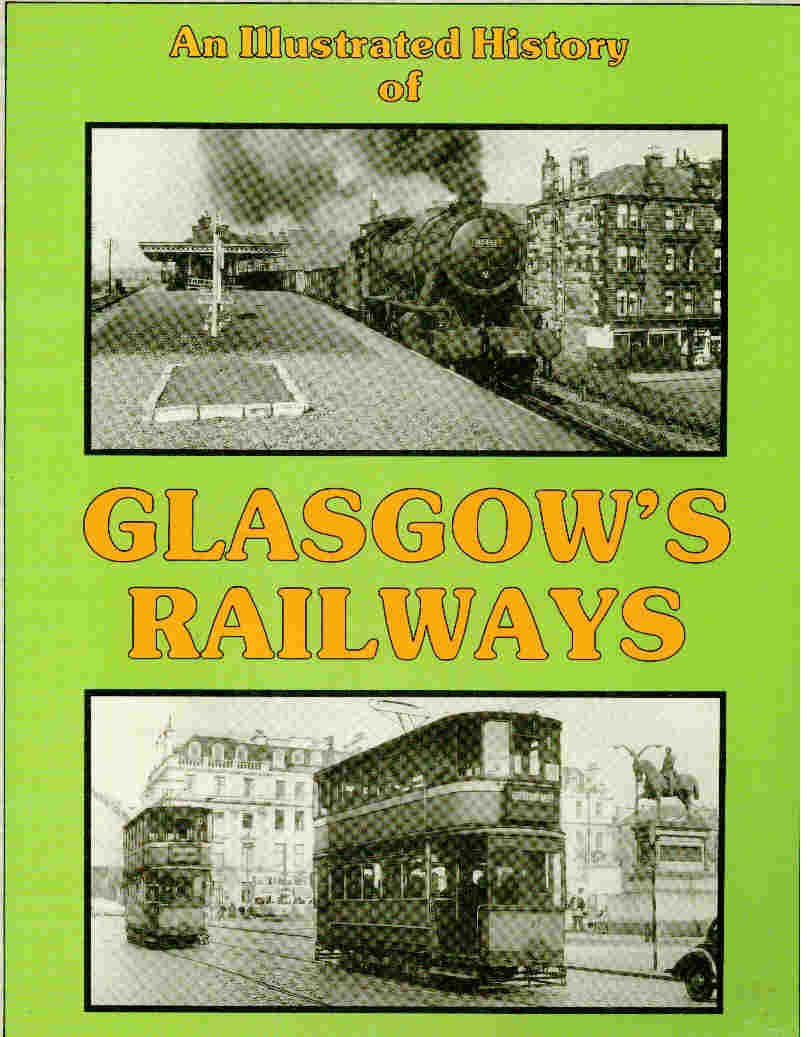Glasgow and Milngavie Junction Railway
Introduction
This railway runs between Milngavie Junction (now Westerton Junction) at Westerton and Milngavie and has stations at Bearsden, Hillfoot and Milngavie.
The line is also known as The Milngavie Line and The Milngavie Junction Railway.
Why built
This line was promoted to service the mills of Milngavie and serve the houses which were expected to be built in the area.
It was initially single track, was doubled as traffic increased and has been partly singled - it reduces to a single track at Westerton Junction, redoubles west of Bearsden, singles again north east of Hillfoot and doubles again at Milngavie.
Service
The Service consists of electric passenger trains running half-hourly through Glasgow to Springburn. Services are operated by ScotRail on behalf of Strathclyde Passenger Transport. A Sunday service has started recently. There is no freight service.
Dates
| / /1861 | Glasgow and Milngavie Junction Railway Act receives Royal assent. |
| / /1863 | Glasgow and Milngavie Junction Railway Villas start being built near Bearsden station. |
| / /1863 | Glasgow and Milngavie Junction Railway
Forth and Clyde Junction Railway Local coach operators start a service between Milngavie and Balfron stations. |
| 28/08/1863 | Glasgow and Milngavie Junction Railway Line opened as a single track. Stations at; Bearsden, Milngavie. The line ran from Milngavie to Milngavie Junction (later renamed Westerton Junction) with trains continuing to Glasgow Queen Street High Level until the Glasgow City and District Railway opened after which trains started to serve Glasgow Queen Street Low Level. |
| 01/08/1874 | Glasgow and Milngavie Junction RailwayNorth British Railway Glasgow and Milngavie Junction Railway absorbed by North British Railway. (Or 31/07/1874.) |
| / /1880 | Burnbrae Dye Works Dye works opened beside the Glasgow and Milngavie Junction Railway by Thomas Reid. Served by a siding, Burnbrae Goods, from the line which originally joined facing south. |
| / /1899 | Glasgow and Milngavie Junction Railway Milngavie station was re-built and a canopy was added to the original station building. |
| 24/04/1900 | Glasgow and Milngavie Junction Railway The line was doubled from Milngavie Junction to Milngavie. |
| 01/05/1900 | Glasgow and Milngavie Junction Railway Hillfoot station opened. |
| 01/09/1913 | Glasgow and Milngavie Junction RailwayGlasgow, Dumbarton and Helensburgh Railway Westerton station opened at the junction of the Milngavie line with the Singer line. Westerton Garden Suburb was being established in what was previously farmland to the north of the line. |
| 08/07/1930 | Bennie Railplane
Glasgow and Milngavie Junction Railway Test track opened above the Burnbrae Goods branch of the Milngavie line. |
| / /1956 | Bennie Railplane Glasgow and Milngavie Junction Railway Test track scrapped. |
| / /1959 | Glasgow and Milngavie Junction Railway Line electrified as part of the Clyde north bank electrification. |
| /07/1959 | Glasgow and Milngavie Junction Railway Failed Class 303, in use for driver training, replaced temporarily by British Railways Eastern Region Tilbury sets. Driver training was carried out on the Milngavie line, reversing at Westerton. |
| / /1960 | Glasgow and Milngavie Junction Railway Ellangowan Paper Mill goods branch closed. |
| /01/1960 | Glasgow and Milngavie Junction Railway Class 303 Blue Trains re-introduced for driver training. |
| /01/1960 | Glasgow and Milngavie Junction Railway Tilbury sets returned. |
| / /1983 | Glasgow and Milngavie Junction Railway Track of platform 3 at Milngavie lifted. |
| / /1983 | Glasgow and Milngavie Junction Railway Northbound platform at Bearsden loses its building. |
| / /1986 | Glasgow and Milngavie Junction Railway Hillfoot goods yard site cleared (loading bank and small shed removed) to make way for housing. |
| / /1988 | Glasgow and Milngavie Junction Railway Bearsden station building rebuilt and enlarged to become a 'Beefeater' restaurant. |
| / /1990 | Glasgow and Milngavie Junction Railway New station building at Hillfoot demolished after a period of time as a taxi company office. |
| / /1992 | Glasgow and Milngavie Junction Railway Line singled from Milngavie Junction to just west of Bearsden and from just east of Hillfoot station to just south of Milngavie station. |
| / /1995 | RAILSCOT Website Website construction begins with the Glasgow and Milngavie Junction Railway page |
| /06/1997 | Glasgow and Milngavie Junction Railway Bearsden station is refurbished at a cost of £500K, with a new shelter, raised platforms and repairs to the footbridge. |
Route described
This line is in the north west of Glasgow. It runs from Westerton northwards on a meandering route through Bearsden to Milngavie.
The line was originally single track, then doubled and now partly singled again.
Portions of line and locations
This line is divided into a number of portions.
Westerton to Milngavie
The main portion of this line runs from Westerton Junction to Milngavie.
This junction is immediately west of Westerton station. Here trains leaving Glasgow divide between the line west and the Milngavie branch.
...
See also
Glasgow, Dumbarton and Helensburgh Railway
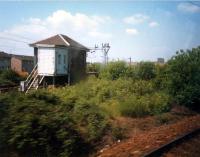
Ewan Crawford //1987

...
David Prescott 13/06/2018
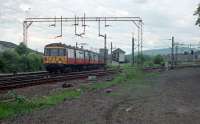
Ewan Crawford 06/06/1989

Ewan Crawford //
This is a two platform station with the modified former main station building and a modern waiting room both on the Glasgow bound platform.
...

John McIntyre 23/11/2018
Hillfoot station was opened after the railway was doubled between Milngavie Junction and Milngavie in 1900. The down platform building at Bearsden and the up and down platform buildings at Hillfoot were all of the same style. The southbound station building was the larger.
...
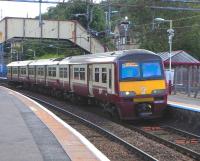
David Panton 08/08/2009
This small one road shed was on the east side of the passenger platforms of Milngavie station, approached (like the station) from the south. It was sandwiched, the goods yard was to the east.
...
This is a two platform station with original sandstone single storey station building fitted with a newer canopy.
...

John Yellowlees 18/05/2017
Burnbrae Goods Branch
This branch ran originally from a south facing junction (which was modified to face north, joining the line just south of Milngavie station) to the [Burnbrae Dye Works]]. The Bennie Railplane ran overhead the west portion.
This is a two platform station with original sandstone single storey station building fitted with a newer canopy.
...

John Yellowlees 18/05/2017
Near Milngavie the formation of tracks leading to the Burnbrae Dye Works lie under the Allander Sports Centre. Little remains of the works branch save a railway bridge over a stream which may be found to the north east of the Sports Centre. A single goods shed (now a "Kelvin Timber" outlet) remains at the dye works (site now occupied by the demolished bus garage).
...

Ewan Crawford //

Ewan Crawford //
This dye works was opened beside the Glasgow and Milngavie Junction Railway by Thomas Reid. It was served by a siding, Burnbrae Goods, from the line which originally joined facing south.
...
Ellangowan Goods Branch
This branch ran from just south of Milngavie station to Ellangowan Paper Mill.
This is a two platform station with original sandstone single storey station building fitted with a newer canopy.
...

John Yellowlees 18/05/2017
The Ellangowan Paper Mill branch passed under the former main road in Milngavie to the site of the mills where a number of sidings were available. The branch was really a long siding.
...
Books











